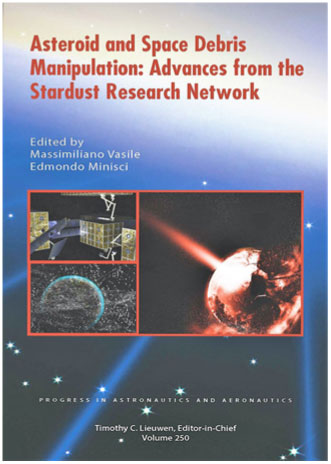
Asteroid and Space Debris Manipulation is an in-depth study of what is the situation with the space environment and the current proposed ideas and techniques to mitigate, if not remove, the threat of asteroid and space debris to space systems and our life on Earth.
The book presents a variety of proposed ideas that have been developed over the last few years to test its feasibility and maturity. The book goes in depth via technical papers to analyse aspects related to the proposed technology to draw conclusions. Recent outbreaks of collision events have demonstrated the necessity of meteoroids and space debris deflection for collision avoidance.
The outcomes that are presented in this book were based on information and studies that were conducted through the Stardust Research Network. The book is compelling. The authors describe their evaluations and analyses while acknowledging the work of some of the already developed techniques. The book’s structure is polished, it consists of 17 chapters and each chapter is a technical paper.
The book begins with space debris evolution and its long-term modelling. Then, the challenge of space debris collision avoidance is presented and analysed. Near-Earth asteroids (NEAs) are then covered in terms of their accessibility and physical properties. Orbit determination, orbital dynamics, orbital stability and orbital control are covered in the middle chapters of this book.
Then, the book focuses on the space debris situation, debris deflection, active removal and mitigation techniques, so deflection of asteroids and space debris are the focus of the later parts of the book. The book emphasises the importance of constant awareness and the necessity of tracking NEAs and space debris to prepare in the case of an uncooperative object (See Chapter 15, page 399). The book also highlights where there is a need for improvement and further development, for instance on page 489 in Chapter 17, where it says, ‘the model used to calculate the deflection action are subject to improvement and further development to fully account for the physics of the interaction with the asteroid…’.
I think one of the main strengths of this book is that the outcome of each chapter is the resultant work of research groups at different universities across different countries. I believe the authors achieved what they set out to achieve in each chapter, as the chapters provide a range of fundamental materials and practical applications of key enabling technologies for future studies. Readers, especially for those who are familiar with the space environment issues, will be interested in the results presented in each chapter of this book. To be sure, there are some weaknesses in printing the book in black and white as I think some figures need to be presented in colour, for clarity. Nevertheless, the book provides some valuable outcomes of the Stardust Research work that are for most of the space community crucial.


